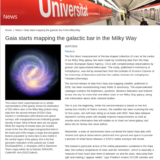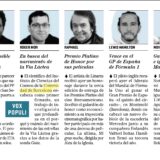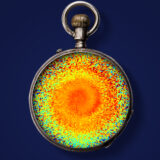Gaia starts mapping the galactic bar in the Milky Way (Notícies UB, 16/07/2019)
Gaia starts mapping the galactic bar in the Milky Way (Notícies UB) The first direct measurement of the bar-shaped collection of stars at the centre of our Milky Way galaxy has been made by combining data from the Gaia mission (European Space Agency, ESA) with complementary observations by ground- and space-based telescopes. The study, published in Astronomy & Astrophysics, was led by researchers from the Institute of Science Cosmos of the University of Barcelona and from the Leibniz Institute for Astrophysics Potsdam (Germany). The second release of data from Gaia star-mapping...
read moreRoger Mor: En busca del nacimiento de la Vía Láctea (El Mundo, 13/05/2019)
ROGER MOR En busca del nacimiento de la Vía Láctea (El Mundo) El científico del Instituto de Ciencias del Cosmos de la Universidad de Barcelona encabeza como primer firmante, un trabajo de investigación que profundiza en el porqué y cuándo del nacimiento de las estrellas de la Vía Láctea gracias a los datos de la sonda Gaia.
read moreUn inesperado ‘baby boom’ de estrellas en la Vía Láctea (El Mundo, 13 Mayo 2019)
Un inesperado ‘baby boom’ de estrellas en la Vía Láctea Científicos de Barcelona descubren que buena parte de los astros de la galaxia nacieron en una época en la que quedaba poco gas. El choque con otra galaxia pudo haber reactivado su formación Date: 13 Mayo 2017 Media: El Mundo Link to the new: https://www.elmundo.es/ciencia-y-salud/ciencia/2019/05/13/5cd7140bfc6c83be238b477e.html La historia de una estrella es una historia convulsa. Como la de las galaxias en las que viven. Y gracias a una nave espacial que está estudiando más de mil millones de astros los científicos están...
read moreThe article “El primer mapa 3D de la Vía Láctea” published in the Spanish version of Scientific American
By: C. Jordi, E. Masana Journal: Investigación y Ciencia, Nº 510, march 2019 Language: Spanish The article on the ESA’s Gaia space mission by Carme Jordi and Eduard Masana, researchers from the Barcelona Gaia team at the Institute of Cosmos Sciences UB, has been published on March in the journal Investigación y Ciencia. La misión Gaia, de la ESA, ha cartografiado con una precisión sin precedentes 1300 millones de estrellas de la galaxia. Sus resultados están cambiando la forma de ver y entender nuestro entorno cósmico. ¿Cómo se formó la Vía Láctea? ¿De dónde proceden las estrellas que...
read moreGaia detects a shake in the Milky Way
Image: The spiral shape of fig 1c of our article appears inside an old watch symbolising the fact that these data has allowed us to date back the perturbation that shook the Milky Way disk. This figure shows how from the new obtained Gaia data we can know more about the past of the Galaxy. Credit: Edmon de Haro/iStock. Researchers of the UB and the University of Groningen lead one of the first big discoveries from the Gaia Mission, published in Nature A team led by researchers from the Institute of Cosmos Sciences of the University of Barcelona (ICCUB, UB-IEEC) and the...
read moreGaia Second Data Release Event in Barcelona.
[UPDATED] See the event video here or at our YouTube channel On Wednesday 25 April 2018, the European Space Agency (ESA) publish the second data release of the Gaia mission. The team of researchers from the Universitat de Barcelona (ICCUB/IEEC) organises an event open to the general public in the Faculty of Physics (Av. Diagonal 647, Barcelona) where the new data will be presented and the new era in astronomy that it begins will be described. Gaia: a billion stars in movement Gaia Second Data Release Event Aula Magna Enric Casasses, Facultad de Física, Universitat de Barcelona Wednesday 25...
read more










